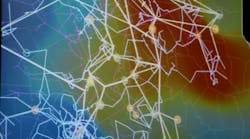Knowing what is occurring in many places at one time — and being able to process that information quickly — is critical to the success of an electric grid operator.
Today, two grid operators are using a visualization tool, designed by their own in-house experts, that is helping their operations teams maintain that awareness more efficiently and effectively than ever before, and it is available at no cost to other entities that can benefit from this type of resource.
ERCOT, the operator of the electric grid serving most of Texas, and Southwest Power Pool (SPP), grid operator in 14 states in the central United States, use a tool in their control rooms called the Macomber Map® to provide a geographical depiction of their systems. This visualization software offers comprehensive and customizable views of power flows, constraints and numerous other inputs, available on command, in both their control room environments and training simulations.
An ERCOT team in 2007 completed initial development of the first Macomber Map, which upon its release was named for Gary Macomber, a human factors engineer who originally envisioned the project and died unexpectedly before its completion. It has played an integral role in ERCOT operations ever since.
"Gary believed that the best way we can succeed is to empower our human beings to be successful, and if we empower our operators to do their best, that benefits us the most," said Mike Legatt, who was a software developer on the project at the time and now serves as ERCOT’s principal human factors engineer.
"With integration of more renewable resources, changes in market design, faster synchrophase information and other changes, we understood that, for the human being, the mission was getting more complicated and complex," Legatt said. "We realized that the one way we could best set our operators up for success was by giving them systems that allowed them to have very strong situation awareness and good decision-making support."
Legatt, who was a key player in the initial project’s completion and continues to lead efforts to encourage its adoption by other users, notes the project has always been a collaborative effort.
"While I may have written the code, it’s really the operators who wrote the Macomber Map," Legatt said. "It’s all the users — operators, engineers and other groups within our organization — that have really defined how the tool grew and developed into what it is today."
In 2013, ERCOT took that collaboration further by releasing the code for the map to the open source community for adoption by other users, such as governments, utilities, emergency responders and anyone who could benefit from this type of enhanced situation awareness. Version 2.0 of the code is now available, with a variety of enhancements and an improved graphic interface, which Legatt attributes to the work of SPP’s developers and operators.
"One of the things that’s very interesting is that, in addition to being a piece of code, the Macomber Map ultimately is a philosophy of collaboration — between our developers and our operators, within our organizations and between our organizations to try to move toward a place of resilience," Legatt said.
SPP has been using the Macomber Map in its operations since March 2016 and recently added the tool to its operator training module. For SPP, the Macomber Map has represented an evolutionary step forward in terms of both reliability and software development.
"Our experience using and contributing to the enhancement of the Macomber Map is a great illustration of a new way of thinking, both about the relationships between technology and grid reliability and between independent grid operators like ERCOT and SPP," said Cody Parker, SPP’s supervisor of Operations Support. Parker supervises the team of engineers and programmers responsible for integrating the Macomber Map into SPP’s real-time operations toolset and developing some of the new features now available in Macomber Map 2.0.
Working with Legatt to understand the tool’s architecture and with operations staff to understand how its users can and want to use the map, Parker’s team ensured the tool is quick, responsive and intuitive enough to help operators make timely and informed decisions when electric reliability is on the line.
SPP’s developers have tailored the Macomber Map to aggregate and analyze historical and real-time data from their energy management, markets, weather and other systems. In doing so, the tool enables operators to construct and assess "what-if" scenarios to better monitor and mitigate against the effects of congestion and potential outages on the bulk electric system.
"The Macomber Map is a great asset to the folks in our control room," said C.J. Brown, the manager of SPP’s balancing authority functions. "The process by which SPP and ERCOT have collaborated on the tool’s refinement and best practices in its application provides huge value to both organizations and the entities they serve. It’s directly helping us maintain reliability in our respective interconnections."
ERCOT also has been using the map in its training exercises since 2009. This has enabled participants that include operators from ERCOT, as well as generation and transmission operators from within its system, to visualize system restoration in black-start exercises and other simulated scenarios.
"The Macomber Map offers a realistic simulation that helps train and prepare operators in our system not only for the types of events we have experienced in real-time operations, but also for worst-case scenarios we hope never to encounter," said Woody Rickerson, ERCOT’s vice president of Grid Planning and Operations. "We have seen performance continue to improve in training exercises, and that tells us those operators are even more prepared for success in real-life situations."
To access the source code and more information about Macomber Map 2.0, visit https://macombermap.codeplex.com/. Legatt and others can provide additional information and training support as needed to help other entities customize the map to serve their unique needs.
"One of the benefits of open sourcing the map and building these kinds of collaborations is that different parties need different things," Legatt said. "So every enhancement they make that flows back to the open source community benefits everybody else, moving us all to a better place."


